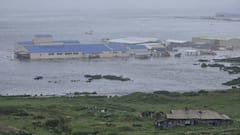Russia Says Ukraine Might Use 'Dirty Bomb', But What Is It?
Russia Ukraine War: Although the bomb doesn’t require highly refined radioactive material used in a nuclear bomb but it could use radioactive materials from hospitals or nuclear power stations .

Russia Ukraine War: Russia's defence minister alleged the possibility of Ukraine using a ‘dirty bomb’, a device containing radioactive material as well as conventional explosives that will escalate the war that has entered its ninth month. However, he has not provided any evidence to support the claims which have been dismissed by western countries including France, the UK, and the US.
What is Russia's claim?
Sergei Shoigu who spoke to the UK's defence secretary, Ben Wallace, informed about his concerns about possible provocations by Kyiv regarding the use of a dirty bomb, reported BBC. Responding to the claims, France, the UK and the US said the governments "all reject Russia's transparently false allegations that Ukraine is preparing to use a dirty bomb on its own territory".
ALSO READ: Proud Of Him Infosys Co-Founder Narayana Murthy Son-In-Law Rishi Sunak Next UK PM (abplive.com)
Ukraine's President, Volodymyr Zelensky refuted the allegation accusing Russia of being "the source of everything dirty that can be imagined in this war".
What is a dirty bomb?
The bomb contains radioactive material including uranium that spreads in the air after the conventional explosive is detonated. Although the bomb doesn’t require highly refined radioactive material used in a nuclear bomb, it could use radioactive materials from hospitals, nuclear power stations, or research laboratories.
Therefore, the dirty bomb is cheaper and can be developed quickly compared to nuclear weapons. The fallout of such material can be dangerous as it may trigger serious illnesses, such as cancer, and such a bomb would cause panic among the targeted population.
Also, a wide region around the blast zone needs to be evacuated for decontamination or abandoned completely. If a bomb containing 9g (0.3oz) of cobalt-60 and 5kg of TNT gets exploded at the tip of Manhattan New York, the whole area of the city would become uninhabitable for decades, according to the Federation of American Scientists calculation.
How dangerous is a dirty bomb?
Dirty bombs are known as weapons of mass disruption but are considered to be very unreliable.
The radioactive material has to be reduced to powder form to ensure that it gets scattered across its target zone. But if the particles are too fine or released into strong winds, they will scatter too widely to do much harm, says the BBC report.
Such a bomb may cause a limited number of deaths. However, its main impact is psychological, and the sole reason such devices are often referred to as “weapons of mass disruption."
The radioactive dust and smoke bear the capacity to spread far and can be dangerous if inhaled near the blast's epicenter. But as radioactive material spreads through the atmosphere, it becomes less concentrated and less harmful, according to the AP report.
When was dirty used before?
So far, dirty-bomb attacks have not been successful anywhere in the world even as several attempts were made, as per the BBC report. In 1996, rebels from Chechnya tried to a bomb containing dynamite and caesium-137 extracted from cancer-treatment equipment in Moscow's Izmailovo Park. Security services were able to discover the location and defuse it in time.
In 1998, Chechnya's intelligence service defused a dirty bomb placed near a railway line in Chechyna.
In 2002, Jose Padilla, a US citizen with al-Qaeda contact was arrested in Chicago on suspicion of planning a dirty-bomb attack. The accused was handed over a 21-year prison sentence.





































